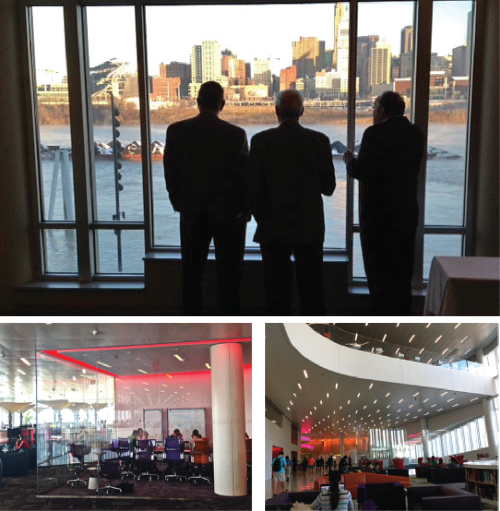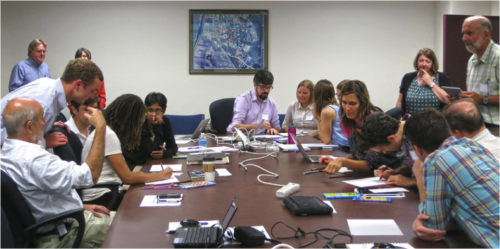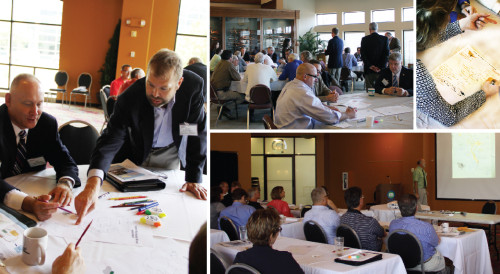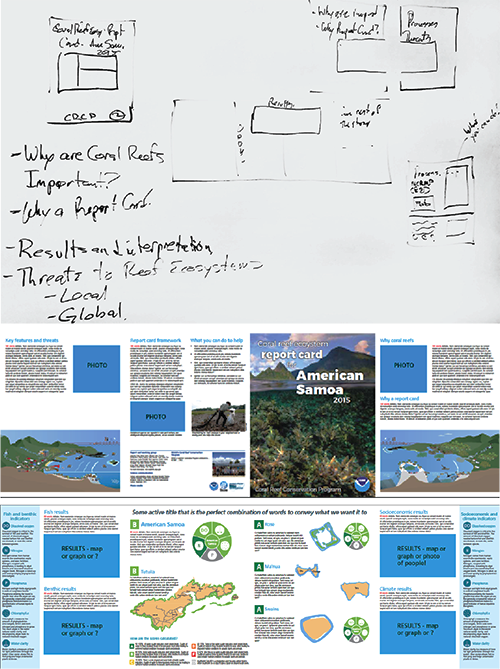How to organize and run short, productive and fun scientific workshops
Bill Dennison ·Five IAN workshop components:
1. Workshop preparation. Workshop preparation is important, but often overlooked. Preparation includes carefully formulating a list of invitees well in advance in order to maximize participation of key people. An attempt is usually made to assemble a diverse set of participants to ensure diverse input and to avoid leaving out potential detractors. It is generally better to have detractors in the room than outside undermining the effort. The venue size and setting is selected to allow easy access, to avoid cramped rooms, and to allow for breakouts. Data projection capability, white boards and large paper pad needs are catered for, often with backups. Akin to an "inverted" or "flipped" classroom, some workshop materials are provided as short recorded videos (10-15 min each) to avoid "Death by PowerPoint" at the workshop. Newsletters or fact sheets are often provided in advance, but entire white papers are not usually provided to avoid excessive homework. Workshop timing to avoid starting on Mondays or ending late on Fridays is preferred.

2. Workshop structure. Workshop structure minimizes workshop length but maximizes contact and input. Depending on the logistics and composition of the workshop, start times are typically late morning, allowing people travel time and also allow for an opportunity to read through emails or make phone calls so that they have cleared their day for the workshop. For a one day workshop, we generally try to break the workshop into two half days for two reasons. One reason is that discussions on the initial day of any workshop are typically driven by the various agendas brought forward by participants. Having "vented" their respective agendas in day one, sharing a drink or meal with other participants in the evening, day two is often more productive in terms of collective, focused effort. Another reason is that the evening of day one and morning of day two allows the workshop facilitators to adjust the activities and schedules as needed, and for interim synthesis, conceptual diagram creation, storyboard and mock-up to take place.

3. Workshop approach. The IAN approach is to provide structure, but allow flexibility . The overall approach is to carefully orchestrate the beginning and ending plenary sessions, but allow flexibility and interactivity for the other sessions. The opening plenary session is designed to establish the workshop objectives, provide personal introductions and provide enough content to inform and guide discussions. This session is planned carefully as it sets the stage for the rest of the workshop and a poorly arranged and/or executed initial plenary session is deadly. Any scientific content presented in this session needs to be vetted beforehand and condensed into 15-20 min talks per person. Interactive sessions and breakout group discussion with report back plenary sessions follow the initial plenary session. All presentations are preloaded before the sessions to avoid wasted time. The final plenary is important for summarizing the workshop findings, lay out next steps with assignments and provide closure for the participants. Multiple extended breaks are scheduled to maximize interactions, allow participants to check emails and make phone calls and give facilitators opportunities to adjust the schedule. Abundant natural light or at least artificial light is preferred to avoid a passive theatre atmosphere in the workshop venue and facilitate interactions.

4. Workshop follow-up. Timely and iterative follow-up is important. It is important to have a timely follow-up and complete the workshop summary document while it is still fresh. The longer the interval between the workshop and the report/newsletter, the more difficult it is to achieve consensus. Participants begin to reinterpret what they heard at the workshop over time, so it is important to capture the workshop consensus in a timely manner. A useful follow-up is to post a blog or a series of blogs with workshop photos and some of the workshop discussion topics. In the place-based workshops, it is useful to develop a blog describing the essential attributes of the ecosystem, known as the environmental literacy. These blogs can be posted within a week or two of the workshop prior to the dissemination and editing of the workshop newsletter. As part of the workshop follow up, it is useful to conduct a debriefing to identify issues that arose, gain feedback to improve subsequent workshops and develop a strategy for finalizing workshop outcomes.
5. Workshop products. "The product drives a collaborative process" is a motto of the IAN team. Co-producing a workshop document serves to create a working relationship between participants and the product provides a tangible workshop output. A key workshop outcome is the collaboration among diverse stakeholders. A key aspect of a scientific workshop is to identify the participants and their respective institutions. This can be done by obtaining a group photo, which takes preplanning for good timing, composition and setting. Obtaining relevant logos and permissions is a crucial part of the workshop product(s).

Employing principles of effective science communication is a critical aspect of developing a workshop product(s). The workshop product storyboard is often developed within the workshop, but the follow-up phase is when the relevant graphics are developed, photos located and maps created. The editing that takes place after a completed initial draft document is prepared can be a valuable collaborative process.

By employing these techniques, IAN workshops are productive, interactive, condensed, participatory and fun.
- IAN workshops are productive, typically generating a product like a fact sheet/newsletter. Workshops that produce a newsletter with a group photo and participant's names and affiliations serve to "bookmark" the event for future reference, and allow successive workshops to build upon one another.
- IAN workshops are interactive, and through various activities, breakouts and assigned tasks, there is ample opportunity for input and exchange.
- IAN workshops are designed to be as condensed as possible so that workshop time is limited to the necessary minimum.
- IAN workshops are participatory with multiple opportunities for input, even using online, real-time feedback voting tools for people not inclined to speak up.
- IAN workshops are fun, with games like conceptionary, poems and songs to summarize the issue and poke fun at participants. These somewhat silly workshop songs and poems are topical and help solidify workshop findings and they also are memorable, helping to distinguish the workshop from other workshops.

IAN workshops produce an actual finished product in a timely manner, allow opportunities for input, value participants' time while they co-produce the output and have fun in process. By employing this approach to workshops, participants are more likely to be willing to attend future workshops, answer phone calls and emails, and collaborate with the organizers and other participants.
About the author
Bill Dennison

Dr. Bill Dennison is a Professor of Marine Science and Vice President for Science Application at the University of Maryland Center for Environmental Science.
Next Post > Workshop on ecological drought with the South Central Climate Science Center in Norman, Oklahoma
Comments
-
Willson 10 years ago
Nice informative post. How did you come to the conclusion that the new method is more enjoyable?

